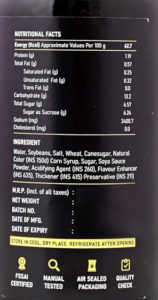One year following India’s ban on specific single-use plastic items, a recent study conducted by Toxics Link, titled “India’s Single-Use Plastic Ban,” has discovered the prevalent use of these prohibited plastic products in five major Indian cities – Delhi, Mumbai, Bengaluru, Guwahati, and Gwalior, notably in local stores and markets. Although certain single-use plastic products (SUPPs) were officially banned on July 1 last year, it seems that the enforcement of this ban remains largely ineffective. This evident violation casts serious doubt on India’s endeavours to reduce plastic pollution.
The worldwide production of plastic waste, totalling approximately 400 million tonnes annually, continues to pose a significant environmental challenge due to insufficient management capacity. At the core of this issue is the prevailing ‘take, make, use, and dispose’ model that characterizes the plastic economy, promoting the widespread use of SUPPs. This leads to the generation of vast quantities of non-biodegradable waste, often carelessly discarded and ultimately finding its way into landfills and oceans. Subsequently, this waste breaks down into micro- and nano-plastics, posing a grave threat to the entire ecosystem.
In an effort to address this problem, India implemented a ban on specific SUPPs nationwide from July 1, 2022, aiming to reduce the usage of products with low utility and high littering potential that harm the environment and public health. Nearly a year since the ban’s introduction, it is crucial to assess its effectiveness and understand the challenges in its implementation. This study sought to evaluate the ban’s implementation, analyse the availability of substitutes for SUPPs, and identify the obstacles to their adoption. The resulting report offers key recommendations to enhance compliance and achieve a substantial reduction in the use of SUPPs.
To evaluate the accessibility of SUPPs and their potential substitutes, surveys were conducted in five cities spanning different regions of India. Subsequently, interviews were conducted with relevant stakeholders to gain insights into the impediments hindering the transition to substitute products. The findings revealed that, of the five cities surveyed, Delhi exhibited the lowest level of compliance with the ban’s implementation, with banned SUPPs still accessible at 88% of the surveyed locations. In contrast, Bengaluru displayed the highest level of compliance, with SUPPs available at 55% of the surveyed points. Gwalior (84%), Mumbai (71%), and Guwahati (77%) also reported a substantial presence of SUPPs at the surveyed locations. This raises concerns as, nearly one year post-ban implementation, SUPPs continue to be available at more than half of the surveyed points in these five cities.
Though consumption of banned items has gone down, especially in branded sector, there is still large-scale use in many segments. The informal economy, largely, continues its SUPPs usage, especially plastic carry bags, cutlery, straws, etc. In-depth analysis of the collected data gives an insightful view and points out the SUPPs that have been affected by the ban and the ones that have suffered limited impact.
The most abundantly found SUPP in all cities was restricted carry bags (mainly plastic carry bags <120 microns); their average availability was as high as 64%. Similarly, SUPPs such as thermocol for decorations, balloon and earbuds with plastic sticks were widely available. This is highly disappointing as substitutes for these SUPPs are easily available in the market. On the positive note, use of plastic stirrers and plastic sticks in ice cream was not noted in any of the five surveyed cities. Another positive outcome is the reduction of plastic cutlery, straws, cups and plates in eating places.
The overall availability across cities for these SUPPs is below 30% while the availability of sustainable substitutes is higher. Another key point observed in the survey findings is availability of SUPPs and its correlation with location type. For example, street food (chaat) vendors, coconut sellers, vegetable vendors and small stalls in markets, weekly and wholesale markets do not comply with the ban in all five cities, but formal eating places, malls and metro stations mostly obey the ban. This probably indicates that ban compliance is driven by the economics and the degree of enforcement at a location; formal or branded locations that can afford substitutes and are monitored strongly under laws have to a large extent switched to substitutes. In comparison, a street vendor or a small shopkeeper are yet to switch to substitutes as they are weakly regulated and also because of the cost of substitutes. However, small, a price margin makes a substantial difference to them. Shopkeepers/ vendors also find the availability and their access to substitutes to be a challenge.
Another important factor that decides compliance appears to be consumer behaviour; many shopkeepers say that consumers demand SUPPs.
Regulatory agencies in one of surveyed state says that for the first year of the ban, the focus has been more on larger establishments and ensuring compliance there. Also, the attempt has also been to cut off supply. The issue of livelihood is also another factor to be considered, while being not so stringent in the informal economy, but the next phase is expected to focus on that. Another state agency points out the lack of economically feasible substitutes as a key factor.
Finally, the study presented recommendations based on the findings and stakeholder inputs. First, the enforcement and monitoring process needs to be stronger and uniform across locations. For this, the study suggests that, in addition to the regulatory agency increasing its vigilance, third monitoring could be helpful. Second, the study suggests that the availability of SUPPs can be reduced only when the supply of banned products is disrupted with effective monitoring at the manufacturing level. Regular checks are recommended at the manufacturing units.
Availability of economically and functionally feasible substitutes will need market-based policy tools to incentivise production and adoption. For instance, economic incentives should be provided to substitute manufacturers — raw materials for substitutes could be made tax free or subsidies added to make production cheaper. Additionally, training and skills needed for the incubation of substitute micro-enterprises should be conducted.
Last, stakeholder engagement should be fostered and inputs from all stakeholders regarding the bottlenecks should be incorporated in the implementation process. Since customers are one of the most important stakeholders, environmental education and regular campaigns should be used to increase awareness and reinforce ban-compliant consumer behaviour. The study proposes that the penalties collected while enforcing the ban should be used to conduct regular monitoring, awareness campaigns, skill development and distribution of substitutes to SUPPs.
Though malls and metro stations show strong adherence to the ban, the study finds that shopping markets, weekly markets, and wholesale markets have major enforcement gaps. Despite their controlled environments, plastic carry bags are also frequently used on railway platforms, bus depots, and tourist spots. Furthermore, despite the availability of viable alternatives, the continued presence of SUPPs in the food business, including restaurants, food stalls, and street food vendors in all cities, raises serious concern about the effectiveness of the product ban.
“Single-use plastics play a significant role in exacerbating the plastic pollution crisis, and the study’s findings highlight significant deficiencies in the ban’s enforcement in India, particularly within the informal economy. The unrestricted use and circulation of banned single-use plastics are alarming, and their open sale on e-commerce platforms is equally concerning,” remarked Priti Banthia Mahesh, Chief Programme Coordinator at Toxics Link. She emphasized, “While alternatives are accessible in the market, it is equally important to adopt a life cycle approach to assess these substitutes before their widespread adoption.”
In Delhi, one of the surveyed cities, significant usage of banned SUPPs has been noted during the study. In a shocking finding, the study reports that 100% of the surveyed vegetable shops, and markets, including wholesale and weekly, sweet shops, bus depots, and chaat shops in Delhi are providing restricted plastic carry bags, indicating its widespread usage and possible littering. Usage of plastic carry bags was very high in other points as well, including tourist spots and small restaurants. Disposable cups, straws, and plates, made of plastic, are available at 54%, 45%, and 43% of the points respectively, indicating a high volume of use. Thermocol for decorations, balloons, and earbuds with plastic sticks are available at almost all surveyed points in the city. The use of the banned products was seen in 100% of the food stalls and chaat vendors, coconut water sellers, grocery shops, markets, and bhandaras. Interestingly, SUPPs were absent in malls and ice cream parlours.
“It is important to recognise that while progress has been made, there is still a substantial journey ahead in curbing the prevalence of single-use plastic products in our cities. The varying levels of compliance across different locations and product types highlight the complexity of this challenge,” said Satish Sinha, Associate Director at Toxics Link. He adds, “Stakeholders must come together and build on the positive shifts observed while addressing the areas that require immediate intervention. Our goal is to cultivate a sustainable ecosystem that not only enriches our communities but also safeguards our planet.”
Key Findings
According to the survey data, SUPPs are still easily available across all five cities. Amongst the surveyed cities, Bengaluru is the most ban compliant with SUPPs in use at 55% survey points. Delhi is the least compliant city as 88% of survey points still provide SUPPs.
- The survey data points out that the outcome of the ban is different for different SUPPs. Restricted carry bags, mostly plastic bags (<120 microns), is the most commonly available banned item — found at 64% of the total survey points.
- Despite having substitutes in the market, products such as thermocol for decoration (74%), balloon and earbuds with plastic sticks (60% each) are also widely available.
- The survey did not record any use of plastic stirrers and plastic sticks in ice-cream parlours across all five cities.
- All other SUPPs are available in all cities.
- An overall reduction in the use of plastic cutlery, cups, plates and straws is visible across eating joints in all cities. The average availability in total survey points is below 30% for these SUPPs, while availability of substitutes to these products is higher than 30% in most cities. It is also encouraging to see that around 90% of survey points used substitutes to plastic plates in nearly all five cities. However, it is also disheartening to see that more than 50% of the survey points in Delhi still use plastic cups and cutlery.
- In the case of SUPPs such as plastic straws, cutlery and sometimes carry bags, users often drink/ eat straight from their cups and plates and shopkeepers hand out products without any carry bag. This is a positive shift that leads to a reduction in total waste generation.
- Higher percentages of coconut water sellers, juice shops, street food (chaat) and vegetable vendors and shops in markets are not ban compliant.
- Another commercial location that could be the potential source of SUPPs are party decoration shops. Most party decoration shops across all cities, except Bengaluru, continue to sell SUPPs.
- Compliance is higher in locations that are strictly regulated, such as malls and metro stations. Most religious spots in all five cities are also ban compliant.

















